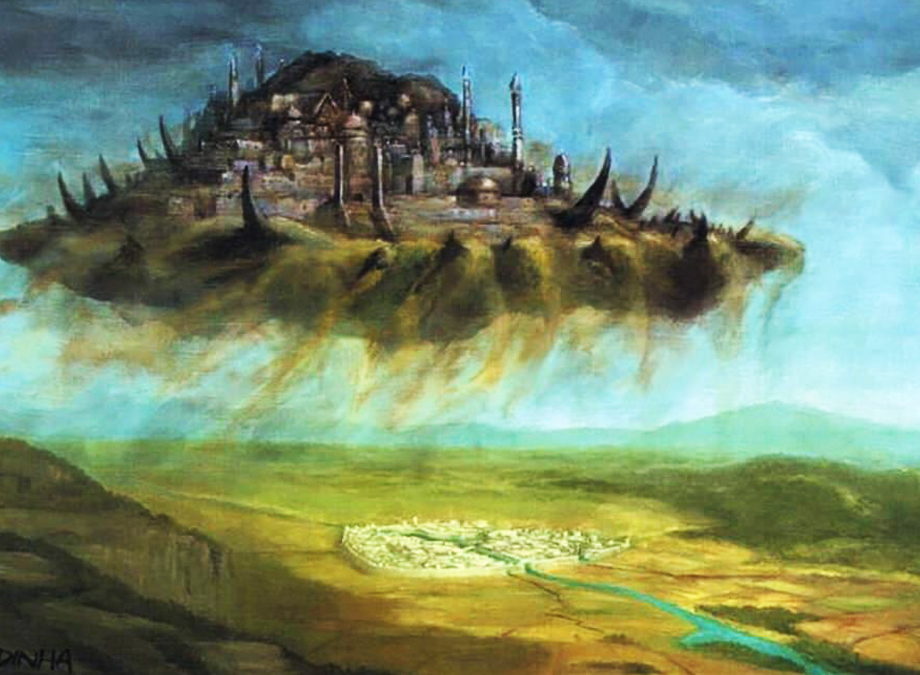The problem with going into discussions of modern Faerun, as with many worlds, is the sheer amount of history behind every stone in every road. Much like the writings of Tolkien, much can be made out of the historical significance of every town, every city, every title that has ever been held.
Much like Italy is built on layers of history that date back even before Rome, so too is Faerun built atop the ruins of ancient civilizations. Among the standard elven and dwarven nations that you might expect to wander through the ruins of also stood a human nation.
A human nation that we have mentioned briefly in passing.
Specifically, the human magocracy that was the Netheril Empire.
Welcome to Lore-Win, the Dungeons and Dragons lore series. I, as always, am your humble Loremaster, Sokar. Today we’ll be scrying back through time and taking a look at an ancient civilization, its people, and how it affects Faerun today.
The Rise of Netheril
The Netherese were a group of pale-skinned, dark-haired humans. The name “Netherese” comes from the region that they came from. In the Age of Humanity, starting in the year of -3000 DR, Netheril was known as a verdant paradise. Nestled up against the Narrow Sea, Netheril was full of rivers, lakes, forests, and plains.
The people here had organized themselves into an alliance known as the Alliance of Seventon. Like the Ten Towns, this alliance was a loose union between seven fishing villages.
One of these towns, Gers, was ruled over by a shaman king named Nether. In celebration of this newfound alliance, Nether created a calendar to mark the passage of time. He called this calendar, “Netheril Years”, because why be an egotistical tyrant unless you name everything after yourself?
Nether’s egotism didn’t end there, either. Through the years, he demanded greater and greater tributes from the alliance, and he continued to name things after himself.
The growing union proceeded to do what all fledgling empires do. They expanded, they removed nearby threats, and they caught the attention of those who would exchange knowledge.
It was -3830 DR when the nearby wood and moon elves of Eaerlann taught his people “the Art”, or as we know it today, “magic”. The Netherese in turn took to arcane spellcasting with a fervor. In turn, Nether renamed the growing nation “Netheril”. Or, more egotistically, “Nether’s Land”.
Their attunement to magic saw the Netherese teaching every citizen at least a basic level of arcane knowledge. Even the lowliest commoner at least knew some cantrips to aid with their cleaning.
As they improved, the magocratic roots of Netheril began to take hold. A faction known as the Arcanists formed. These were spellcasters unmatched in their craft, and in the hierarchy of Netherese society they were second only to the nobles.
At least, for now.
By the way, Nether’s thanks for naming everything after himself was getting assassinated. Well, probably not that reason exactly.
Over the next millennium, the magical prowess of the Netherese continued to improve by leaps and bounds. In -3533 DR, the Netherese discovered ancient scrolls known as the Golden Skins of the World Serpent. These were a series of scrolls dating back tens of thousands of years which contained fundamental magic theory.
And, in true Netherese fashion, they renamed them the Nether Scrolls.
The Netherese turned to these scrolls as a preferred method of learning magic. Aided by a lich of the race that created these scrolls, they translated the scrolls and soon began to craft their own magical items. Netherese mages also struck out, attacking other nations, and stripping away arcane spells from their sorcerers.
The Height of an Empire
The start of a new age was marked in -3315 DR by the birth of one of Netheril’s greatest arcanists. Ioulaum, a man whose name that even I dare not pronounce, became a famed figure in his thousands of years of life.
By this time, the more prestigious Netherese arcanists had begun to live for extended periods.
Sometime within his first 200 years of life, Ioulaum drew prestige for himself when he defended Netheril from a horde of orcs. Once he defeated them, he then took them captive, and experimented upon them.
Then, in -3014, Ioulaum made another great discovery for Netheril. This was the year that he created the first mythallar.
Mythallars were crystal ball-like constructs, but much larger. 150 feet in diameter, to be specific. They convert raw magic from the Weave, which could then be used by the Netherese. This discovery became all the more useful in light of another creation of Ioulaum’s.
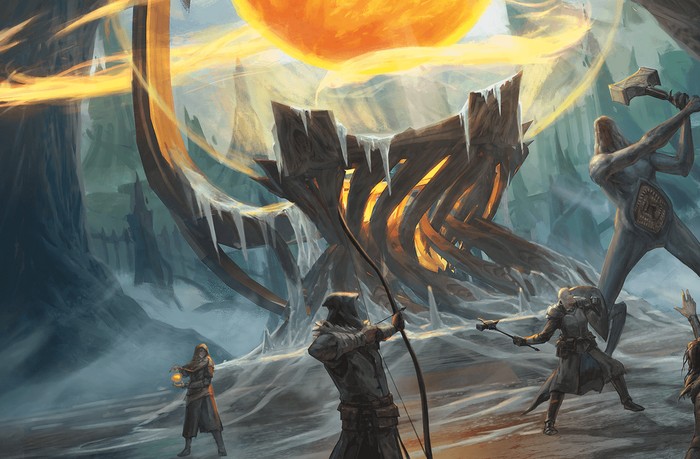
A mythallar being fought over.
Source: Icewind Dale: Rime of the Frostmaiden
In -3011 DR, the great arcanist created another invention: the quasimagical item. These were items with magical properties that were always active. Ioulaum’s first creation was a mantle that both allowed the user to see in the dark, and read the surface thoughts of others.
Normally, these quasimagical items would need energy from the Weave. But when within range of a mythallar, they could use the arcane energy derived from it instead. This created a booming market for the middle class, and magical lights and water sources were introduced to the lives of Netherese citizens.
In -2954, Ioulaum created yet another wonder of Netherese society: the first flying city. This, the first of the flying Netherese Enclaves, was called Xinlenal, and it created a division in the empire. With their greatest and brightest arcanist having made a flying enclave, now every archmage wanted to, and those with enough wealth and power flocked to these flying cities to live away from those they viewed as beneath them.
This led to High Netheril and Low Netheril. With the Low Netherese now literally being under those who claimed to be their betters. The laws of these flying enclaves were passed down by their archmages, and each contained a mythallar.
As the next millennia went on, Netheril expanded.
In -2758, they expanded their government, creating the new ruling council of the High Mages of Netheril. Then they expanded westward. Moving to the Sword Coast, the Netherese set up more enclaves and settlements. One of these settlements, Quesseer, acted as a tradesmeet that served Illuskans, Illefarn elves, and dwarves.
Netherese arcanists continued to make great strides in arcane knowledge, soaring to greater and greater heights. Dozens of flying enclaves floated above Netheril. Chronomancy was founded. The Netherese built an enclave beneath what would become Waterdeep. And in time, the Netherese even left the boundaries of Toril itself, taking off into space through vessels known as spelljammers. A topic that I WILL BE GETTING TO.
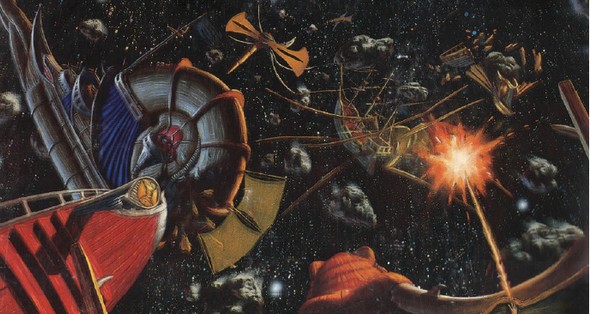
Spelljammer: Space battles in D&D. What's not to love?
Source: Spelljammer: War Captain's Companion (2e)\
Having flown to such heights, it seemed only a matter of time until the other boot dropped.
The Fall
And when it did, it did so quite literally.
The final age of Netheril was also marked by the birth of a legend. The arcanist Karsus was born in -696 DR, and he quickly proved to be a savant in magic. Karsus attained a near-instant mastery in spellcraft during his studies, and accomplished feats such as creating his own flying enclave, and creating a new form of magic known as heavy magic.
In this age, Netherese arcanists continued to make voyages outside the material plane. One group of arcanists ventured to the Demiplane of Nightmares in -681 DR, not to be confused with the Demiplane of Dread. This was a realm inhabited by nightmarish creatures. The archmage Telamont Tanthul also emigrated from the prime material plane, taking his enclave Thultanthar with him to the plane of Shadow in -339 DR.
These may or may not come back to haunt everyone later on.
But Netheril’s greatest accomplishments would soon lead to a great threat.
The flying enclaves had long showered the earth beneath them with magical residue. What they hadn’t realized was that this magical residue had become an affliction for a malevolent, leech-like subterranean race known as the phaerimm.
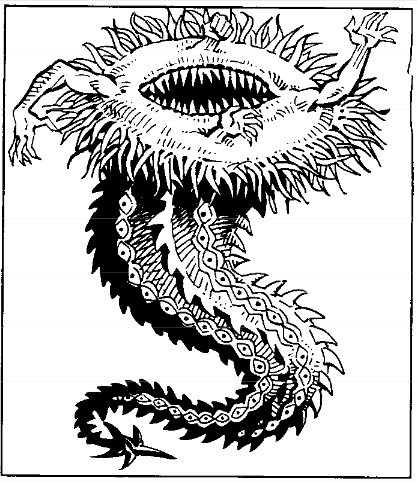
An image of a phaerimm.
Source: Nethril: Empire of Magic (2e)
The phaerimm grew enraged by their torment and retaliated against the Netherese. The war proved destructive to both the empire, and the world itself. In -461 DR, the phaerimm began draining life and magic from the land, and from the flying enclaves. This resulted in once lush lands being reduced to barren wastelands and deserts, with chaotic wild magic affecting the regions. Some of the flying enclaves would fall from the sky, and Netheril was left a desert.
As a result of the destruction unleashed upon Netheril, arcanists began to flee the nation. Those of High Netheril fled for safer lands, while those of Low Netheril fled to different nations altogether. Some Low Netherese arcanists chose to resettle in the magocracy of Illusk, an ancient city that stood where Luskan now resides.
The flight of the arcanists led to the commoners of Netheril fleeing their homes as well.
And then came true calamity.
Karsus had devised a spell unlike any other. A spell with such strength that it could steal the power of the gods. It took six hours to cast this spell, and of course Karsus named it after himself.
Karsus’s avatar, as it was known, would have stolen the powers of then-goddess of magic, Mystryl, and let Karsus ascend to godhood. Its casting has since been named Karsus’s Folly.
The spell tore apart the Weave that had already been so damaged by the war with the phaerimm. It caused such damage that Mystryl had to sacrifice herself to prevent its destruction. And with the death of the goddess of magic, so too did arcane magic cease to function.
The magocracy of Netheril fell. Literally. Mythallars ceased to function, and the flying enclaves came crashing to the ground. Other enclaves were destroyed as well, like the Sarguath Enclave, which had been constructed beneath what is now Waterdeep.
And so, in a matter of hours, the great Netheril Empire ceased to exist.
To The Future
Not all of the enclaves fell though. Despite the destruction caused by Karsus, when Mystryl was reborn as Mystara, she managed to catch three of the flying cities and save them from destruction.
Several Netherese successor states existed for a time, before being destroyed or abandoned. The scattered Netherese settled in other civilizations and tribes, though some that had traveled to other planes would return at some point. Often with less than kind intentions.
The fallout of Karsus’s Folly saw Mystara restrict access to epic spells from spellcasters, believing that mages were not responsible enough to properly cast such powerful magics. The phaerimm were in turn defeated by a mysterious race of aberrations known as the sharn. So at least their draining of life was stopped.
As for Karsus’s Avatar, the spell has gone missing. It is whispered by some that Mystara swept in to steal away the instructions to cast it, and sent them speeding towards the end of the universe itself.
The story of Netheril is a warning to those mages that believe themselves to be gods. A warning to not think too highly of themselves. Though, some like Ioulaum still live on to this day, though in forms different than what you may anticipate.
But that is a story for another day.
In the meantime, if you’d like to add something from Netheril to your campaign, the ancient ruins of a magical empire contain endless hooks for adventure. Whether your party is searching through the ruins of a fallen enclave, like in Neverwinter Nights: Shadows of Undrentide, or seeking the lost knowledge of the empire.
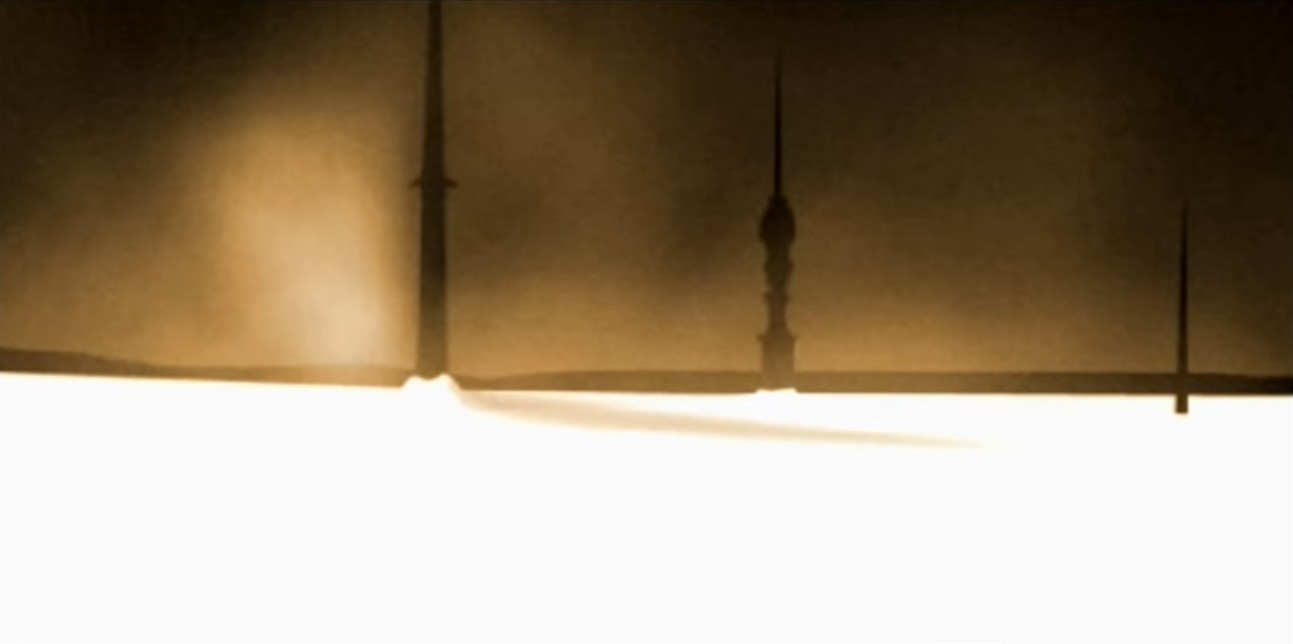
The flying enclave of Undrentide, buried beneath the sands.
Source: Neverwinter Nights: Shadows of Undrentide
And if you or your party needs supplies for your next D&D adventure, you can find them at the Wizard’s Tower.
Until next time, may fortune favour you.
-Loremaster Sokar

